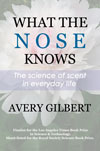
In What the Nose Knows, I stressed that what sets perfumers apart from the rest of us is not the sensitivity of their noses, but the way they have learned to think about smell. They learn to identify the raw materials of perfumery by memorizing ever-finer discriminations within the basic fragrance families: floral, citrus, woody, etc. They learn to mentally analyze novel perfumes with reference first to general types (e.g., Oriental) and then to more specific subtypes (floral-Oriental). Anyone with a working sense of smell can attempt this training, just as anyone so inclined can learn to distinguish the varietal character of different types of wine.
In the physical realm, professional practice of this sort results in measurable changes in brain organization. For example, the motor control areas devoted to fine movements of the left hand is bigger than average in violinists, suggesting that the brain reorganizes according to the functional demands made upon it. Now a team of French researchers has extended this logic into the realm of perfumery.
Jane Plailly and her colleagues studied brain activation during odor perception and odor imagination in 14 student perfumers and 14 full-fledged professionals. Why odor imagery?
for the average person it is much easier to imagine visual images than olfactory ones. In contrast, perfumers have learned to form olfactory sensory representations through daily practice and extensive training. Furthermore, they claim to have the ability to produce perceptual images of smells in the total absence of odorants. Forming mental images of odors is thus a crucial component of the perfumer’s expertise.Another reason is to compare brain activity during odor imagery and actual odor perception. We know that visual imagery is a real mental phenomenon because it activates the same brain areas that function during actual visual stimulation. Thus, Plailly et al. recorded brain activity with fMRI as each subject sniffed 20 different odors; they compared the results to activity as the subject imagined the same 20 odors (cued by their printed names).
The students were from ISIPCA in Versailles and therefore familiar with the raw materials and their names. The odors were delivered through a standard oxygen mask as the subject lay in the MRI magnet; delivery was timed to the subject’s respiratory cycle. The odors used were:
aldehyde C-11, alpha-damascone, benzyl acetate, beta-ionone, citronellol, dihydromyrcenol, eucalyptol, eugenol, lavandin (essential oil: EO), lemon (EO), linalyl acetate, linanol, methyl anthranylate, orange (EO), phenylethyl alcohol, sandalwood (EO), spearmint, tangerine (EO), triplal, and vanillin.Plailly’s team compared brain activity while smelling odor X to brain activity while imagining odor X. Across students and professionals, similar areas were active during perception and imagery. “This result showed that mental imagery can induce the activation of the primary olfactory brain region.” In other words, olfactory mental imagery is real and it happens the same way as visual imagery.
The researchers found no difference between professionals and students in response to actual odors. When it came to odor imagery, however, there were significant differences. Compared to students, the professional perfumers showed decreased activity in three specific mini-regions of the brain. This seems paradoxical at first—remember that violin practice creates larger left-hand motor control areas—but it can be explained.
The areas in question deal with olfactory character and association. With a professional’s experience, it takes relatively less mental effort to imagine a specific odor. Tell him “dihydromyrcenol” and he quickly brings it to mind; activation of the brain areas used during odor identification is no longer necessary to create a mental image of a familiar smell.
Think of crossword puzzles as an analogy. A novice counts the squares before filling in a likely word; the seasoned crossword hound knows at a glance if his answer fits the spaces available. As Plailly et al., point out, this automatization of response is a useful thing: it is, for example, what frees the piano player from thinking about the notes and allows him to relax and concentrate on the expressive aspects of the music.
Our findings thus demonstrate that training can alter the neural processes that are activated when imagining an odor. Whereas the creation of an odor mental image was a more automatic mnestic process in professional perfumers, this process needed to be supported by previously encoded associations in student perfumers. More strikingly, by comparing the functional data obtained during odor imagery with the level of experience in professional perfumers, we revealed the functional reorganization of several brain regions. When imagining an odor, the experienced perfumers exhibited lower levels of activity in key regions involved in olfactory and memory processing: the primary olfactory cortex (bilateral aPC [anterior piriform cortex] and right pPC [posterior piriform cortex]), the left and right hippocampus and the left olfactory orbitofrontal cortex.I like this study for a couple of reasons. It examines a phenomenon—olfactory mental imagery—that happens in the real world, and uses naturally occurring groups—students and professionals—in its experimental design. Finally, it gets at the cognitive processes that are central to the sense of smell. There’s a lot more to be done, but this is a fine start.
The study discussed here is “Experience induces functional reorganization in brain regions involved in odor imagery in perfumers,” by Jane Plailly, Chantal Delon-Martin, Jean-Pierre Royet. It was published in Human Brain Mapping 33:224-234, 2012.























